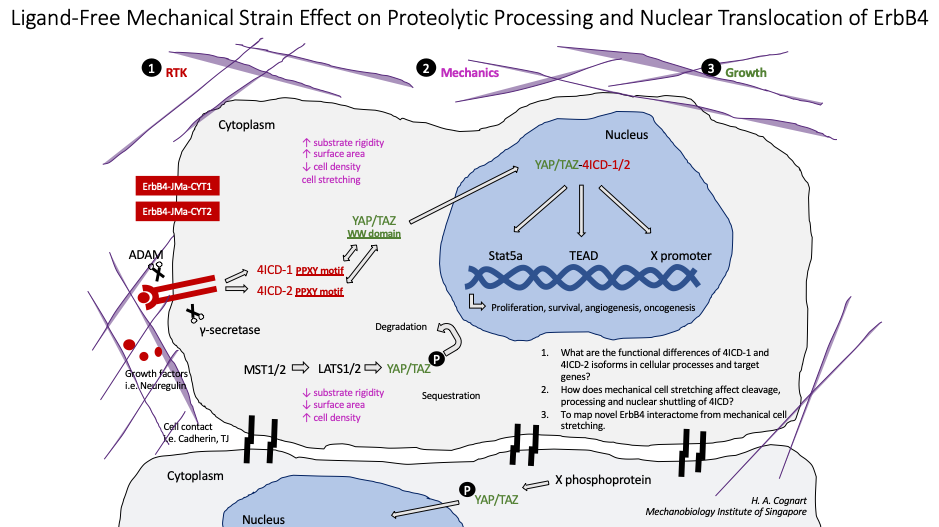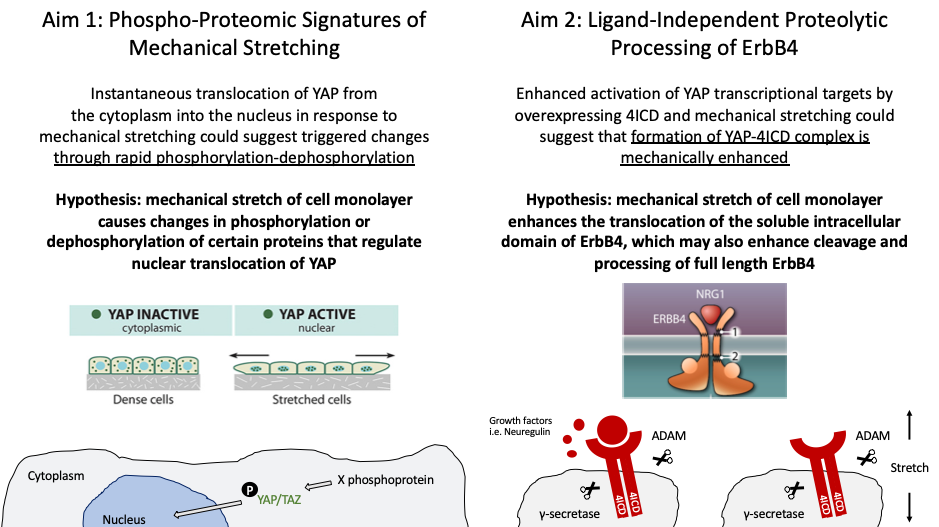
Hamizah COGNART
Research Fellow (2018-2022), Mechanobiology Institute, National University of Singapore
mbihaa@nus.edu.sg
Level 10 T-Lab
National University of Singapore
5A Engineering Drive 1
Singapore 117411
Hamizah Cognart
Research Fellow
Principal Investigator
Graphical Abstract

Research Interests
Dr Cognart’s current research is in the investigation of EGFR tyrosine kinases in tissue morphogenesis of the Hippo-YAP signaling pathway from mechanical cues. Part of the epidermal growth factor (EGF) receptor (EGFR), these kinases are driven largely by their role in promoting cell proliferation and opposing apoptosis. Hence, the EGFR family has been vilified as a proto-oncogene as it is commonly up-regulated in cancers such as in non-small-cell lung cancer, metastatic colorectal cancer, glioblastoma, head and neck cancer, pancreatic cancer, and breast cancer.
Proline-rich PPxY motifs of proteolytically cleaved intracellular domain of ErbB4 receptor tyrosine kinase have preferential hydrogen binding affinities with the WW domains of YAP, which can mediate the output of Hippo tumor suppressor pathway including growth control and cancer development. YAP is a protein that acts as a transcription coactivator of genes involved in cell proliferation and suppressing apoptotic genes. YAP is also known to be regulated by a serine/threonine kinase relay module (MST1/2–LATS1/2) culminating in phosphorylation of YAP at serine 127 and cytoplasmic sequestration. However, YAP also undergoes tyrosine phosphorylation, and the role of tyrosine phosphorylation in YAP regulation remains unclear.
Here, the manipulations of mechanical cues i.e. matrix rigidity and stretching are induced on cell monolayer in order to study:
- Phosphorylation independent regulation of YAP, particularly the role of the ErbB4 soluble intracellular domain (4ICD) as a functional partner of YAP on tissue morphogenesis.
- Regulation of YAP by tyrosine phosphorylation of certain proteins resulting in the translocation of YAP into the cell nucleus.
- Convergence of ErbB4 and Hippo pathway-YAP/TAZ signaling on the remodeling of tight junction cytoskeleton.
- Effects of mechanical stimuli on the cleavage and processing of full length ErbB4.
Research Aims

Education
PhD Université de Paris
Selected Publications
- Cognart HA, Viovy J-L, Villard C. Fluid shear stress coupled with narrow constrictions induce cell type-dependent morphological and molecular changes in SK-BR-3 and MDA-MB-231 cells. Sci Rep. 2020;10(1):6386. doi:10.1038/s41598-020-63316-w
- Cognart HA, Chang C-P. Negative Enrichment of Circulating Tumor Cells in Blood Using a Microfluidic Chip. Methods Mol Biol. 2017;1547:167-174. doi:10.1007/978-1-4939-6734-6_13
- Sajay BNG, Chang C-P, Ahmad H, et al. Microfluidic platform for negative enrichment of circulating tumor cells. Biomed Microdevices. 2014;16(4):537-548. doi:10.1007/s10544-014-9856-2
- Sajay BNG, Chang C-P, Ahmad H, Chung WC, Puiu PD, Rahman ARA. Towards an optimal and unbiased approach for tumor cell isolation. Biomed Microdevices. 2013;15(4):699-709. doi:10.1007/s10544-013-9757-9
- Peters CE, Ahmad H, Kellerman D, et al. Abstract 1451: Microfluidic-based unbiased enrichment (negative selection) of circulating non-hematopoietic tumor cells directly from whole blood without centrifugation. In: Tumor Biology. American Association for Cancer Research; 2013:1451-1451. doi:10.1158/1538-7445.AM2013-1451


